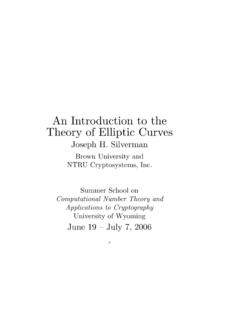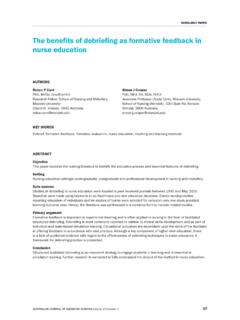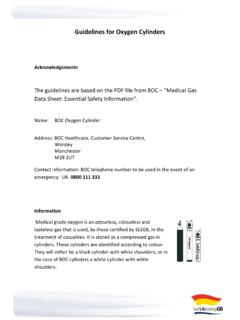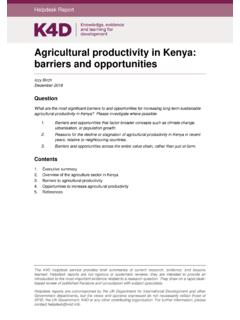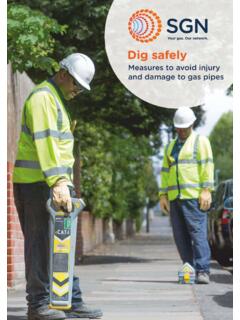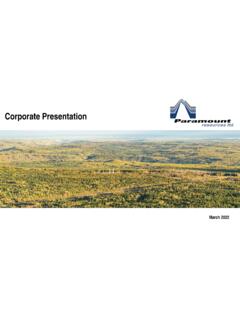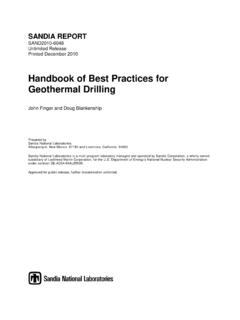Transcription of Survey of Clustering Data Mining Techniques
1 Survey of Clustering data Mining Techniques Pavel Berkhin Accrue Software, a division of data into groups of similar objects. Representing the data by fewer clusters necessarily loses certain fine details, but achieves simplification. It models data by its clusters. data modeling puts Clustering in a historical perspective rooted in mathematics, statistics, and numerical a machine learning perspective clusters correspond to hidden patterns, thesearch for clusters is unsupervised learning, and the resulting system represents a data concept. From a practical perspective Clustering plays an outstanding role in data Mining applications such as scientific data exploration, information retrievaland text Mining , spatial database applications, Web analysis, CRM, marketing, medical diagnostics, computational biology, and many is the subject of active research in several fields such as statistics,pattern recognition, and machine learning.
2 This Survey focuses on Clustering in data Mining . data Mining adds to Clustering the complications of very large datasets with very many attributes of different types. This imposes unique computational requirements on relevant Clustering algorithms. A variety of algorithms have recently emerged that meet these requirements and were successfully applied to real-life data Mining problems. They are subject of the and Subject Descriptors: [Artificial Intelligence]: Learning Concept learning; [Image Processing]: Segmentation; [PatternRecognition]: Models; [Pattern Recognition]: Clustering . General Terms: Algorithms, Design Additional Key Words and Phrases: Clustering , partitioning, data Mining ,unsupervised learning, descriptive learning, exploratory data analysis, hierarchical Clustering , probabilistic Clustering , k-meansContent:1.
3 Notations Bibliography at of Clustering of Further PresentationAuthor s address: Pavel Berkhin, Accrue Software, 1045 Forest Knoll Dr., San Jose, CA, 95129; e-mail: Hierarchical Linkage Metrics Hierarchical Clusters of Arbitrary Shapes Binary Divisive Partitioning Other Developments3. Partitioning Relocation Clustering Probabilistic Clustering Methods Methods 4. Density-Based Partitioning Density-Based Connectivity Density Methods 6. Co-Occurrence of Categorical Data7. Other Clustering Relation to Supervised Descent and Artificial Neural Networks Evolutionary Methods Other and VLDB High Dimensional Reduction Algorithmic of How Many Clusters?
4 data Measures Handling OutliersAcknowledgementsReferences1. IntroductionThe goal of this Survey is to provide a comprehensive review of different Clustering Techniques in data a division of data into groups of similar objects. Each group, called cluster, consists of objects that are similar between themselves and dissimilar to objects of other groups. Representing data by fewer clusters necessarilyloses certain fine details (akin to lossy data compression), but achieves simplification. It represents many data objects by few clusters, and hence, it models data by its clusters. data modeling puts Clustering in a historical perspective rooted in mathematics, statistics,and numerical analysis.
5 From a machine learning perspective clusters correspond to hidden patterns, the search for clusters isunsupervised learning, and the resulting systemrepresents a data concept. Therefore, Clustering is unsupervised learning of a hidden data 2concept. data Mining deals with large databases that impose on Clustering analysis additional severe computational requirements. These challenges led to the emergence of powerful broadly applicable data Mining Clustering methods surveyed below. Notations To fix the context and to clarify prolific terminology, we consider a dataset Xconsistingof data points (or synonymously,objects, instances, cases,patterns,tuples,transactions) in attribute space A, where i, and each component is anumerical or nominal categoricalattribute(or synonymously, feature,variable,dimension,component,fie ld).
6 For a discussion of attributes data types see [Han & Kamber 2001]. Such point-by-attribute data format conceptually corresponds to a matrix and is used by the majority of algorithms reviewed below. However, data of other formats, such as variable length sequences and heterogeneous data , is becoming more and more popular. The simplest attribute space subset is a direct Cartesian product of sub-ranges called a segment (also cube, cell, region). A unitis an elementary segment whose sub-ranges consist of a single category value, or of asmall numerical bin. Describing the numbers of data points per every unit represents anextreme case of Clustering , a histogram, where no actual Clustering takes place.
7 This is a very expensive representation, and not a very revealing one. User driven segmentation isanother commonly used practice in data exploration that utilizes expert knowledge regarding the importance of certain sub-domains. We distinguish Clustering fromsegmentation to emphasize the importance of the automatic learning =),..,(1 CCl = :N1=lilAx Nd ,:1,,dlACAll= The ultimate goal of Clustering is to assign points to a finite system ofksubsets, clusters. Usually subsets do not intersect (this assumption is sometimes violated), and their union is equal to a full dataset with possible exception of ,..1 Clustering Bibliography at Glance General references regarding Clustering include [Hartigan 1975; Spath 1980; Jain & Dubes 1988; Kaufman & Rousseeuw 1990; Dubes 1993; Everitt 1993; Mirkin 1996; Jainet al.]
8 1999; Fasulo 1999; Kolatch 2001; Han et al. 2001; Ghosh 2002]. A very good introduction to contemporary data Mining Clustering Techniques can be found in the textbook [Han & Kamber 2001]. There is a close relationship between Clustering Techniques and many other has always been used in statistics [Arabie & Hubert 1996] and science [Massart & Kaufman 1983]. The classic introduction into pattern recognition frameworkis given in [Duda & Hart 1973]. Typical applications include speechandcharacterrecognition. Machine learning Clustering algorithms were applied to image segmentation andcomputer vision [Jain & Flynn 1996]. For statistical approaches to pattern recognition see [Dempster et al.
9 1977] and [Fukunaga 1990]. Clustering can be viewed as a density estimation problem. This is the subject of traditional multivariate statisticalestimation [Scott 1992]. Clustering is also widely used for data compression in imageprocessing, which is also known as vector quantization [Gersho & Gray 1992]. data 3fitting in numerical analysis provides still another venue in data modeling [Daniel & Wood 1980]. This Survey s emphasis is on Clustering in data Mining . Such Clustering is characterized by large datasets with many attributes of different types. Though we do not even try to review particular applications, many important ideas are related to the specific in data Mining was brought to life by intense developments in informationretrieval and text Mining [Cutting et al.
10 1992; Steinbach et al. 2000; Dhillon et al. 2001],spatial database applications, for example, GIS or astronomical data , [Xu et al. 1998; Sander et al. 1998; Ester et al. 2000], sequence and heterogeneous data analysis [Cadez et al. 2001], Web applications [Cooley et al. 1999; Heer & Chi 2001; Foss et al. 2001], DNA analysis in computational biology [Ben-Dor & Yakhini 1999], and many resulted in a large amount of application-specific developments that are beyond our scope, but also in some general Techniques . These Techniques and classic Clustering algorithms that relate to them surveyed below. Classification of Clustering Algorithms Categorization of Clustering algorithms is neither straightforward, nor canonical.








